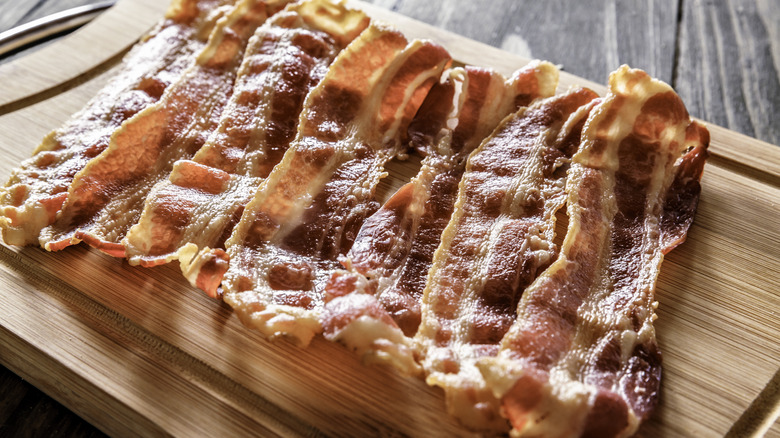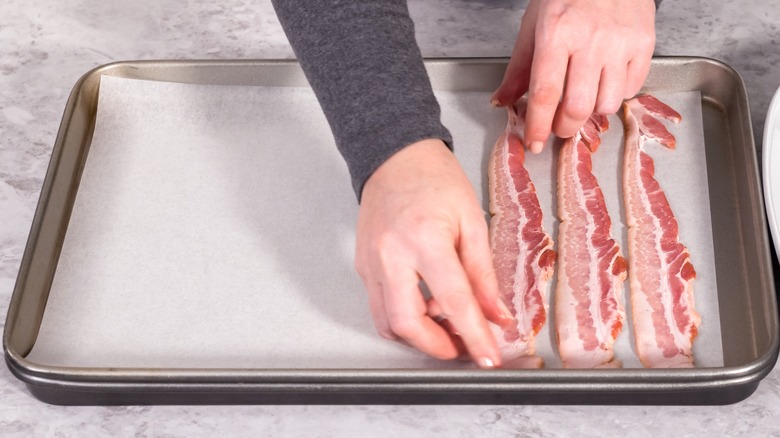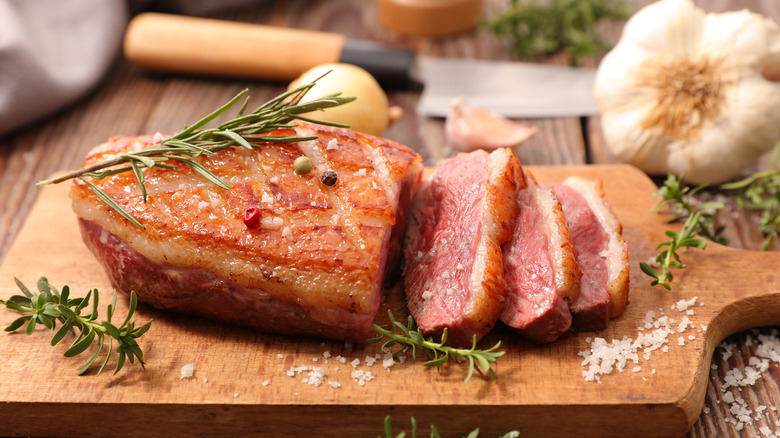A Cold Oven May Be Key To Perfecting Your Bacon
It's one of the first pieces of advice you learn when starting out as a home cook: Pre-heat the oven to the required temperature before you put the food in. After all, surely if a recipe says to cook something at a certain temperature for a particular length of time, then that's what you actually need to do? Well, it turns out that bacon doesn't play by these rules. It's actually better to start cooking the meat in a cold oven, not a hot one.
Using the oven to cook the porky breakfast favorite is one of the hacks that all bacon lovers need to know. It's easy, doesn't require constant watching or turning, is great for cooking a large batch at once — and it's less messy than the stovetop method — especially if you roast your bacon with parchment paper.
No matter whether you prefer your slices shatteringly crisp or with a bit of a chew, for the best results, put the sheet of bacon into the oven before you turn on the heat. What this technique achieves is to help the strips of meat cook more evenly. It's all to do with the fat content of bacon, which needs time to render by being cooked slowly. And a cold oven is the perfect place to start.
Start with a cold oven for crisp and evenly-cooked bacon
Fatty bacon is a tricky meat to cook uniformly. The problem is that the meat can easily burn if the temperature is too hot while the fat can remain stubbornly flabby. And just as you should never cook bacon in a hot pan as it causes the strips to shrivel or scorch before the fat has rendered down, it turns out you shouldn't cook it in a hot oven, either. At least, not to start with.
Rather, simply lay the meat on a sheet lined with parchment, and put it directly into your cold oven. Then turn the temperature to 400 degrees Fahrenheit, and the bacon will begin to slowly cook and evenly crisp up as the temperature rises. It might take up to 20 minutes to cook depending on how thick the bacon is and how fast your oven pre-heats, but just keep checking on it after around a quarter of an hour to see when it's done to your liking.
An added advantage of the cold oven method is that all the tasty fat that melts as the meat cooks can actually be saved and used for other dishes, meaning less waste. Just pour it off the tray into a clean container, and you'll have a stash of versatile cooking fat ready to use. Try using bacon fat to transform caramelized onions – or to make Southern-style biscuits.
Bacon is not the only meat to benefit from a cold start
While it may seem counterintuitive to put meat into a cold pan or oven, sometimes it's the best way. This is especially true with some fattier varieties — duck breasts, for example. If you put them straight into a hot pan, the skin can often burn before the thick fat has a chance to properly melt. But laying the meat with the skin-side down in a cold pan rather than pre-heated means the fat can render while the skin turns crisp, and the flesh stays juicy as the heat gently increases.
This tip also applies to certain meats that you want to roast in an oven – especially for low-and-slow styles of cooking (anything below about 310 degrees Fahrenheit) as the longer time at a lower temperature can help the outside crisp up as the fat within melts. This will help to produce a more succulent piece of protein.
Likewise, if you're planning to braise meat in the oven for a long period, then putting it in before you turn on the heat may also actually improve its texture. The fibers will gently break down as the heat steadily rises, resulting in a tender braise — this works beautifully for tough but fatty cuts like brisket.



